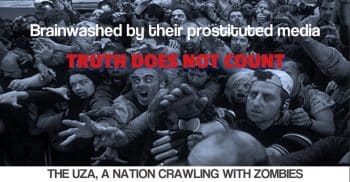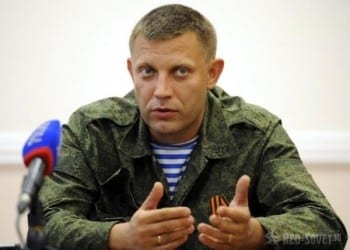By Eduard Popov - translated by J. Arnoldski - July 27, 2017 - Fort Russ -
[dropcap]A[/dropcap]ccording to the head of the Donetsk People’s Republic, Alexander Zakharchenko, what took place on July 18th in Donetsk was a gathering of representatives of contemporary Ukraine’s regions at which the creation of Malorossiya was proclaimed. The congress was attended by delegates from 19 of Ukraine’s regions (not counting Russian Crimea and the former Donetsk and Lugansk regions of Ukraine). The collective opinion of the delegates was that Ukraine as a state can no longer be reformed, hence the proposal to found a new state based on new principles - among which, we should note, is a categorical rejection of Ukrainian Nazism and the Ukrainian oligarchy.
These “founders of Malorossiya” dream of building a socially just state with elements of direct democracy. As stated by DPR Minister of Revenue and Duties Alexander Timofeev (the second man in the republic after Zakharchenko himself in terms of influence), the proclaimed Malorossiya will be a federative state with broad autonomy, its capital in Donetsk, and the state flag of Bogdan Khmelnitsky.
According to Timofeev, a constitution will be adopted at a popular referendum. The minister also emphasized that the creation of Malorossiya does not contradict the Minsk Agreements. The Constitutional Act on the Establishment of Malorossiya declares that the established state will maintain a non-aligned status but will continue to pursue accession to the Union State of Russia and Belorussia. The document also enumerates the social policy of the new state in considerable detail, emphasizing struggling against oligarchy, developing people’s control in the economy, establishing state concerns, etc. The founding document also declares that elements of direct democracy will be introduced alongside criminal liability for propagating the ideas of Ukrainian Nazism and its collaborators (OUN-UPA, etc.). In other words, at the heart of the “constitution” of the still virtual Malorossiya are principles which lie at the heart of the Donetsk and Lugansk People’s Republics.
Later, on July 26th, Zakharchenko explained his own position on the Malorossiya project, saying in an interview: “We have not created a new state, we have proposed a discussion.” Furthermore, in the words of the proclaimer of Malorossiya: “Not everyone supported the idea of the name Malorossiya, and there have also been comments on the location of the capital, the state flag and coat of arms. The composition, format, and time for calling a legitimate constituent assembly that will represent all regions of Ukraine is also being discussed. In other words, final decisions have not yet been made, but, most importantly, the discussion will continue.”
In order to appropriately understand the meaning, context, and packaging of the proclamation of Malorossiya and such subsequent expressions, let us first recapitulate for our readers the historical background of the name and region in question.
The project of creating an independent Ukrainian state and ideology for a separate people, “Ukrainians”, began only after 1917. It is characteristic that this ideology was originally forged by Polish emigrants and local Malorossiyan separatists (the most famous of whom is the icon of the Ukrainian nationalist pantheon, the poet Taras Shevchenko) and was adopted as a weapon by the Bolsheviks in Moscow who, paradoxically, were advocates of political centralism. During the decades of Joseph Stalin’s rule, all education in the Ukrainian Soviet Socialist Republic (including the Russian-speaking and Russian-inhabited Donbass) was held in Ukrainian. Nonetheless, over the whole Soviet period the overwhelming majority of Ukraine’s inhabitants continued to speak Russian with the exception of barely literate villagers, and the residents of the small towns of Western Ukraine (formerly dominated by Polish and Jewish populations) spoke in local dialects sometimes completely incomprehensible to the inhabitants of other regions. The developed industrial cities of the East and South of Soviet Ukraine and the residents of the capital, Kiev, spoke only Russian, and in terms of language and mentality hardly differed from the residents of cities in Russia. As a native of Donbass who finished school in Ukrainian, I can confirm that I almost never heard the Ukrainian language spoken outside of Ukrainian language and literature classes.
..
How this alternative could manifest itself in a concrete political project and just who could be behind such - we will turn to these questions in the following installment.
 Eduard Popov, born in 1973 in Konstantinovka, Donetsk region, is a Rostov State University graduate with a PhD in history and philosophy. In 2008, he founded the Center for Ukrainian Studies of the Southern Federal University of Russia in Rostov-on-Don. From 2009-2013, he was the founding head of the Black Sea-Caspian Center of the Russian Institute for Strategic Studies, an analytical institute of the Presidential Administration of Russia. In June 2014, Popov headed the establishment of the Representative Office of the Donetsk People's Republic in Rostov-on-Don. He has actively participated in humanitarian aid efforts in Donbass and has been a guest contributor to various Donbass media, such as the Lugansk-based Cossack Media Group. Popov has been Fort Russ' guest analyst since June, 2016.
Eduard Popov, born in 1973 in Konstantinovka, Donetsk region, is a Rostov State University graduate with a PhD in history and philosophy. In 2008, he founded the Center for Ukrainian Studies of the Southern Federal University of Russia in Rostov-on-Don. From 2009-2013, he was the founding head of the Black Sea-Caspian Center of the Russian Institute for Strategic Studies, an analytical institute of the Presidential Administration of Russia. In June 2014, Popov headed the establishment of the Representative Office of the Donetsk People's Republic in Rostov-on-Don. He has actively participated in humanitarian aid efforts in Donbass and has been a guest contributor to various Donbass media, such as the Lugansk-based Cossack Media Group. Popov has been Fort Russ' guest analyst since June, 2016.  Later, on July 26th, Zakharchenko explained his own position on the Malorossiya project, saying in an interview: “We have not created a new state, we have proposed a discussion.” Furthermore, in the words of the proclaimer of Malorossiya: “Not everyone supported the idea of the name Malorossiya, and there have also been comments on the location of the capital, the state flag and coat of arms.”
Later, on July 26th, Zakharchenko explained his own position on the Malorossiya project, saying in an interview: “We have not created a new state, we have proposed a discussion.” Furthermore, in the words of the proclaimer of Malorossiya: “Not everyone supported the idea of the name Malorossiya, and there have also been comments on the location of the capital, the state flag and coat of arms.”









